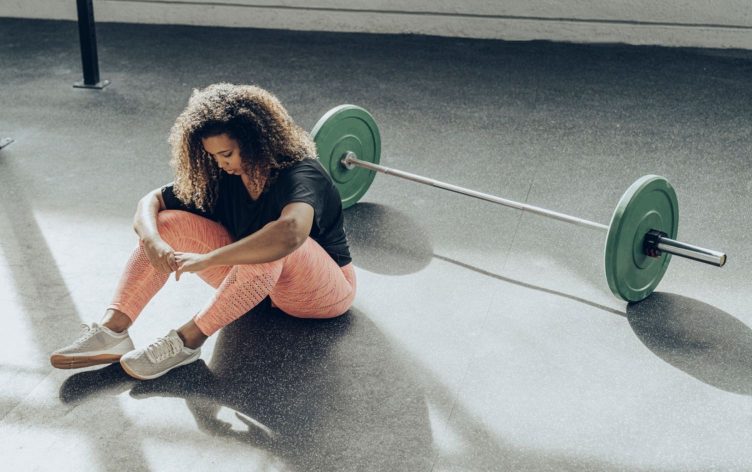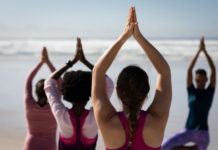
5 Ways to Adjust Your Workout If You’re Dealing With Anxiety
In today’s world, stress and anxiety are high. It’s easy to understand why. “Dealing with a global pandemic is stressful,” says Erin Reynolds, PsyD, a clinical sports neuropsychologist. “People are worried about their own health and the safety of loved ones, particularly those in a higher risk category.”
Many people are now thinking twice about even the most basic errands. “Everything we do these days has an added layer of stress around it,” notes Grace Dowd, LCSW. “If we see friends, we have to stress about where to meet up; if we go to work, we stress about losing our job; if we go to the store there is a stress of contamination. This stress eventually piles up and creates generalized anxiety, which can be difficult to recognize and manage without proper tools.”
One unexpected area where that anxiety can crop up is your workouts. Maybe not in ways you’d initially notice or expect. Here, mental health pros and expert trainers outline how anxiety can affect your fitness efforts, plus how to adapt your routine for today’s times.
HOW ANXIETY IMPACTS YOUR WORKOUTS
Feeling anxiety (or even just extra stress) may alter your sweat sessions in a variety of ways — from obvious to subtle.
YOUR HEART RATE MAY SPIKE SOONER
Heart pounding during your gentle warmup? Anxiety can cause a variety of physical symptoms like increased heart rate, shallow breathing, light-headedness and increased perspiration, according to Dowd. “These symptoms can certainly affect one’s physical performance during exercise.” In particular, a person with anxiety is likely to have their heart rate spike earlier in their workout due to their baseline heart rate already being at a heightened state, she explains. This may mean you’re not able to work out as intensely as usual.
YOU MAY NEED MORE RECOVERY TIME
“There’s some research that suggests chronic psychological stress may impair muscle recovery and somatic sensations — think perceived energy, fatigue and soreness over a 96-hour period,” Reynolds says. What does that mean in real-world terms? “People experiencing anxiety should be more mindful about their recovery periods to avoid injury. Incorporating active recovery days is beneficial so that the body isn’t over-taxed, but you still get the psychological benefits of exercise.”
YOU MIGHT BE LESS LIKELY TO WORK OUT OVERALL
Unfortunately, research shows people with anxiety tend to be more sedentary. “This could be due to social anxiety, which could make it more difficult for someone to physically go to the gym,” Reynolds points out. “In the COVID-19 era, anxiety around cleanliness and hygiene could also make it difficult for someone to feel comfortable in the gym setting.”
WORKOUTS MIGHT FEEL LESS FUN
“Individuals experiencing anxiety may have a harder time finding enjoyment out of their workouts,” Dowd says. “They may find themselves in ‘analysis paralysis’ by overanalyzing all of the possible workout options out there and find themselves unable to decide which one feels best for them.”
THE BEST WORKOUT ADJUSTMENTS
Here’s the good news: if you’re dealing with anxiety, exercise can help. “Having a consistent exercise routine will reduce levels of anxiety, improve focus and improve sleep, which will assist in the restorative recovery process,” says Hillary Cauthen, PsyD, an executive board member for the Association for Applied Sport Psychology.
“Exercise makes you feel good, gives you an endorphin release, helps reduce muscle tension, and diverts what you’re thinking about so you focus less on the things that are causing anxiety,” adds Kia Khadem, a clinical exercise physiologist, nutritionist and online personal trainer.
Here are some pointers for finding the best workout to help with your anxiety.
PICK ACTIVITIES YOU GENUINELY LIKE
“The best type of workout for someone with anxiety is anything they actually enjoy and will keep doing,” Reynolds says. “Exercise should serve as a diversion from stress and anxiety, and it should also be an enjoyable experience. For some, that may be HIIT three times a week, when for others it is yoga six times per week. Everyone will have a different ‘best’ option.”
IF NECESSARY, KEEP THINGS LOW KEY
“Physical symptoms associated with more intense cardio workouts (increased perceived heart rate, shortness of breath, lightheadedness), can be similar to how some people experience more intense anxiety or panic,” Reynolds points out. “In those cases, research suggests it may be best to start with something less intense like yoga or walking; however, experiencing those symptoms during a positive experience like exercise can also help to decrease those symptoms during acute anxiety experiences.”
In other words, getting used to anxiety-like sensations in a non-threatening situation makes them feel less scary when they’re happening because of anxiety. In any case, Reynolds recommends touching base with a therapist (an online one, if necessary) if this is happening to you.
AIM TO DO SOME CARDIO
“The majority of research shows that aerobic exercise is fantastic for anxiety,” Khadem says. Whether you opt for biking, swimming, running or something else depends on your preference. The key is to raise your heart rate in a way that feels comfortable for you. “Everybody will respond slightly differently to different intensities and different modalities.”
TRY WORKOUTS THAT EMPHASIZE THE MIND-BODY CONNECTION
“Yoga and other mindfulness-related activities, such as a mindful walk, may be especially beneficial for people with anxiety,” Dowd says. “They bring us out of our fight-or-flight mode and into the present moment.”
START SMALL
If you’re having trouble getting started with (or getting back to) exercise because of anxiety, Dowd recommends taking manageable steps to approach it rather than avoiding it altogether. “Notice your anxiety and label it for what it is — an emotion that comes and goes. With gradual exposure, we can decrease the anxiety around exercise. Be willing to seek out help from a therapist or personal trainer who can help you navigate some of the stressors that arise when it comes to exercise.”
Make progress on nutrition and fitness goals with our “Plans” feature in the MyFitnessPal app for daily coaching and easy-to-follow tasks.





